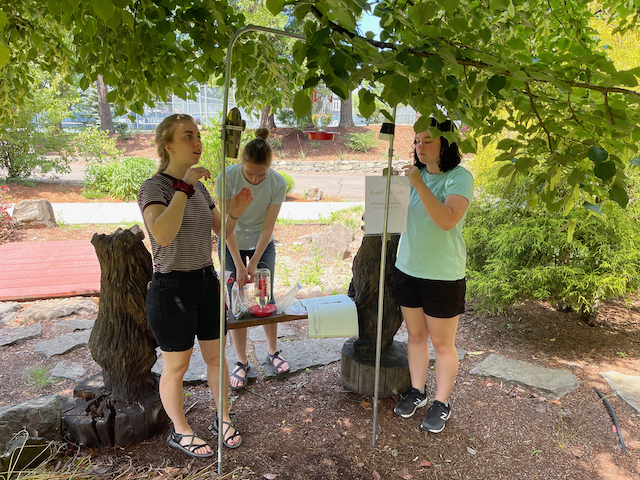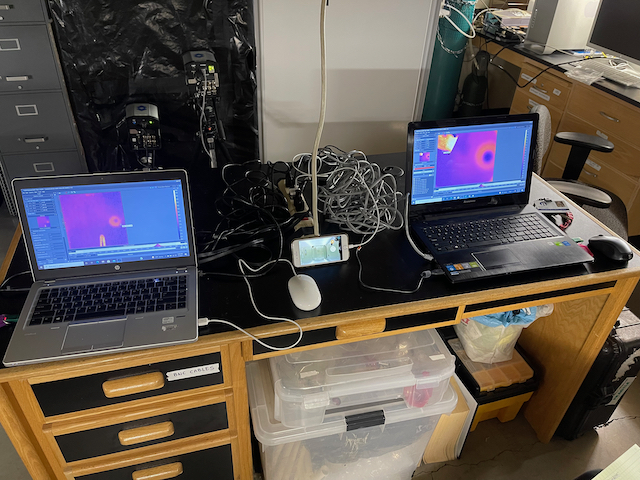Well, this past summer did not go as planned. While we did have a couple projects planned for the George Fox University campus much of what we intended to do would be in the Chiricahua Mts in SE Arizona. You know what they say about the best laid plans. When the American Museum of Natural History decided to close the Southwestern Research Station for the year it sent labs across the country scrambling….including ours. Now, our field season had to shift focus to our small population of Anna’s hummingbirds on the GFU campus and my backyard.

What was intended to be two projects on the GFU campus turned in to five. Our biggest challenge was figuring out how to share a limited number of birds, and to pivot a bit on a couple of the projects so everyone could get their work done. Dr. Anusha Shankar, a Rose Postdoctoral Fellow in the Laboratory of Ornithology at Cornell spent the entire summer with us shifting her torpor genomics project to Anna’s. She and Emily Blackwell teamed for the summer building a lab for nighttime torpor work in the shed outside the Powers home. This allowed all the equipment to be under a roof while the bird was outside subject to natural light and temperature. Emily had to change her protocol substantially in order to share birds with Anusha, but when all was said and done both got great results. One highlight of Anusha and Emily’s work was our first use of thermal windows built in to a metabolism chamber that allowed concurrent measurement of surface temperature and metabolic rate. Data from the work will allow us to show that hummingbird surface temperature during the night is a reliable indicator of metabolic state.

Tiffany Regier and Whitney Dobbyn spent the summer tracking thermoregulatory strategies in free-living Anna’s hummingbirds both on the GFU campus and at the Powers home. Tiffany was originally going to do her work in Arizona, but for the second straight year got bit by Covid restrictions and had to settle for work at home. One nice thing about doing the work at GFU is that we had some remarkably hot days allowing us to see if what we were seeing in the laboratory applied to free living birds as well. On key thing that came out of Tiffany and Whitney’s work was how complex and difficult it is to measure radiative heat gains and losses in birds. This is particularly true for flying birds where radiative heat simply does not appear to move quickly across the plumage. We have designed experiments for next summer that will hopefully help us to get a handle these measurements.

Last but not least Audrey Smith was also bitten by Covid restrictions for the second straight year. For the past two years she had intended to repeat studies we have done on cool-climate calliope hummingbird on warm-climate species in Arizona. However, like the rest of us she had to pivot to working with Anna’s hummingbirds. The silver lining to this shift in focus is the Anna’s is a non-migratory species that must tolerate a wide range of climatic conditions being around for both cold winters and warm summers (particularly this summer). In addition, Anna’s is also a winter breeder making them a somewhat unique species that likely have a number of thermoregulatory tools in the box.
The first thing Audrey needed to do was build a flight chamber that would fit inside our Percival environmental chamber. This gave us a chance to learn to use the laser cutters over in our Maker Hub to precisely cut the pieces which we glued together. Because we needed to image the birds with our IR camera we could not close the Percival door so instead sealed if off with plastic to allow for temperature regulation. Our initial plans were to complete trials at 5, 20, and 35 °C. However, the refrigeration unit went out so we could only do 20 and 35 °C.


Two things that had to happen prior to collecting data on a bird was that they had to be trained to 1) feed from the respiratory mask and 2) use the provided perch so that we could get post-flight perching data. Audrey discovered quickly that each bird had their own personality. Some took to the mask and perch easily and others not so much. Eventually Audrey developed some training strategies that worked for most birds. In the end Audrey got some really interesting results that now has us thinking that heat dissipation post-flight from the perch is a critical part of the body-temperature management for flight at warm temperatures. In the video below note how the bird not only heats its bill and feet, but also the leading edge of its shoulder!
While we were disappointed to not be able to travel this summer there were some really good things that came out of Project Anna’s Hummingbird. The teamwork and relationships that were established in many ways was far superior to any previous year. The entire lab functioned as a big family which was truly fun. Things appear as if they will be sort of back to normal this coming year, but even so this past summer was fun. Go Team Project Anna’s Hummingbird!!










































